French Revolution
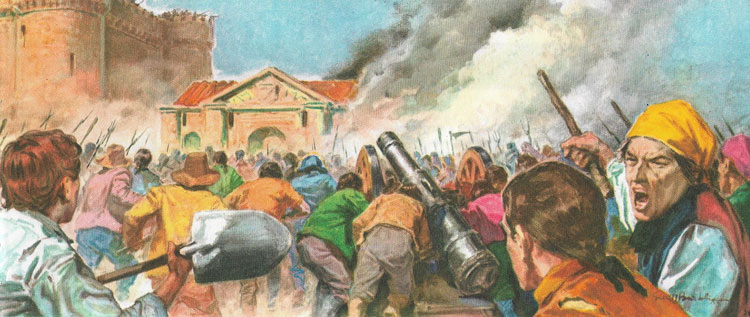
The storming of the Bastille on July 14, 1789 was seen by contemporaries and later generations as the true beginning of the revolution. Although the political crisis began more than a year earlier, the rising of the Paris mob against this ancient prison and symbol of absolutism was of fundamental importance. It forced the basically middle-class National Assembly to ally with the people to prevent a royalist counter-attack and it led to uprisings in the provinces in which aristocrats' estates, were seized, land deeds destroyed and officials murdered. It paved the way for feudalism's downfall, transferring political power from the king to the legislature.
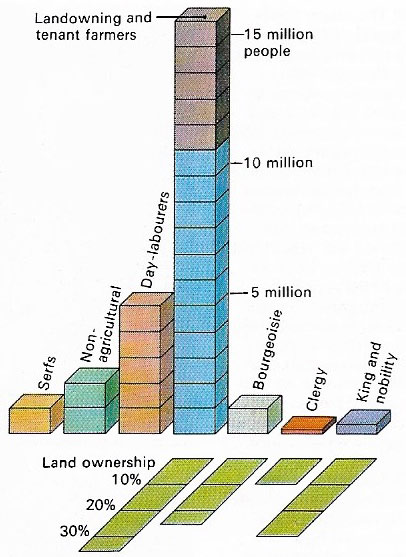
Figure 1. Unequal division of land with more than 40% owned by less than 3% of the population was a major grievance and fundamental problem of French society. As most of the nobility and clergy were largely exempt from taxation, the principal share of the burden fell on the bourgeoisie and the more prosperous of the peasantry.
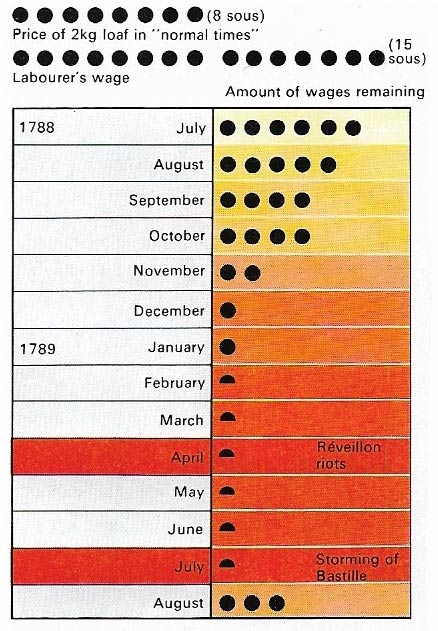
Figure 2. Prices rose steadily during the 18th century as a result of increases in population (more than 50%) and money supplies and relatively slow expansion of industrial and agricultural production. This had the effect of making the upper classes even more determined to hold on to their privileges while the lives of the peasants and industrial workers became even more precarious. In "normal" times a loaf of bread cost a laborer about half a day's wage, but bad harvests in 1788 and 1789 lifted bread prices to the point where they almost matched wages. This precipitated political tension and rioting.
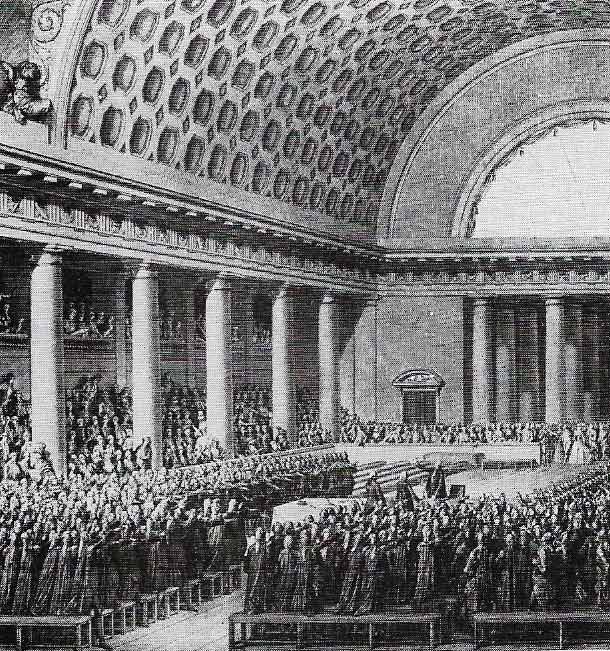
Figure 3. The meeting of the Third Estate as the National Assembly on 17 June 1789 pledged to end feudal privileges, was the political start of the revolution.
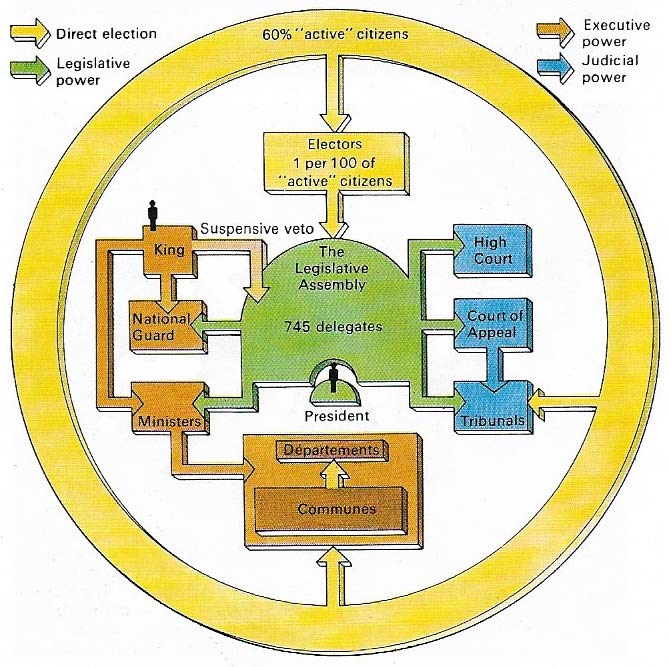
Figure 4. The Constitution produced by the National Assembly was a limited monarchy with power residing in a Legislative Assembly elected by citizens who paid direct taxation at least equivalent to three days' wages of a laborer per year. The 1791 Constitution also divided France into local government départements that are still in use.
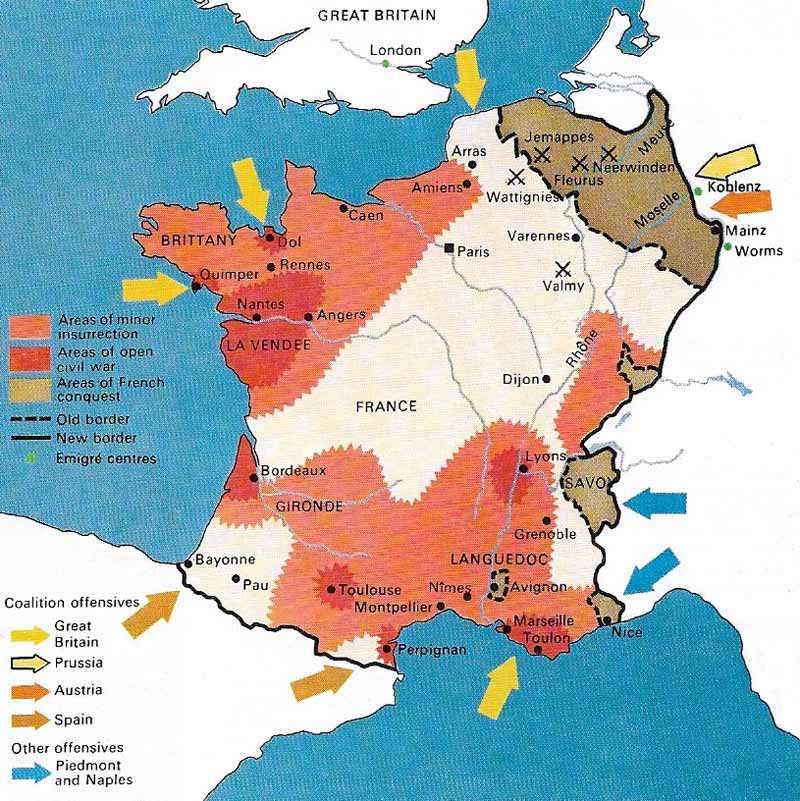
Figure 5. France's neighbors were antagonized by the gathering forces of the revolution. Aristocratic émigrés formed a nucleus of resistance and had support from Austria and Prussia. Their first invasion was halted at Valmy and the republic then counter-attacked, occupying Nice, Savoy, and Belgium after a victory at Jemappes (November 1792), invading the Rhineland states and threatening Holland. After the king's execution, war was declared on Spain, Holland, and Britain but military reverses followed, with a major revolt in La Vendée and enemy offensives in southern France, Belgium, Alsace, and Brittany. Unprecedented emergency measures put down internal revolts, the invasions were repelled and Belgium and Holland were reconquered. By the end of 1795, France had made peace with all its enemies except Austria and Great Britain.
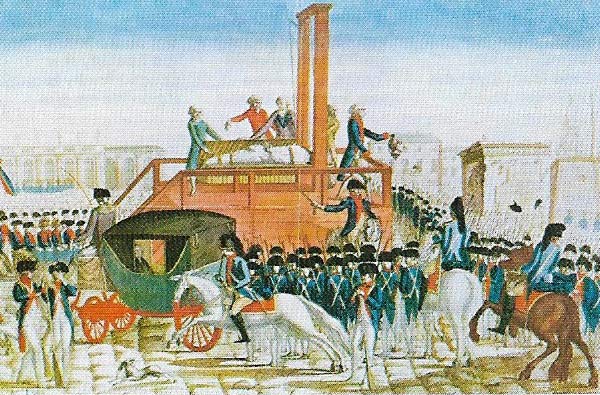
Figure 6. The execution of Louis XVI on 21 January 1793 followed the threat of an invasion of royalist émigrés. Popular opinion turned wholly against the king and the Jacobins were able to seize power and declare France a republic on 22 September 1792. Victory over royalist forces at Valmy gave them the self-confidence to try the king and his execution symbolized the break with the past system.
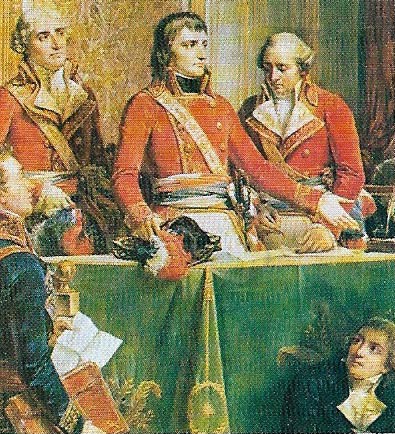
Figure 8. The installation of the Conseil d'Etat on December 24, 1799 made Bonaparte First Consul. With the prestige of his victory in Italy and the Egyptian campaign behind him, Napoleon was the most powerful man in the turbulent political scene at the turn of the century. The failure of the Directorate to solve internal problems had lost it all support and Napoleon hoped to use his widespread popularity to persuade the assemblies to vote him into power without any fuss. But they refused to do so and he had to use troops to drive them out and allow a small rump of supporters to vote through a constitution. This gave power to a first consul who was assisted by two colleagues and a senate nominated by the consuls. Napoleon then made us of a new device – the plebiscite – to obtain popular support. He announced that three million votes had been cast in his favor of the new constitution and only 1,562 votes against it.
It was in the summer of 1789 that the French revolution broke upon Europe. It was one of the most dramatic and important events of all time, and the effects of it were felt not only on France but throughout the world. It marked the beginning of a new age in history, an age in which liberty and equality came to be recognized as the right of everyone.
There were many reasons for a revolution in France in 1789. There were injustice, muddle, and misery. The government was ineffective and out-of-date. The King still had supreme power and the Estates-General had not been called for 175 years. Moreover, there were rigid class barriers, and it was difficult for the ordinary middle or lower classes to have any influence at all on the government of the country.
There was little justice. The government could imprison anyone for as long as it liked without trial. The poor bore the burden of taxation (nobles and higher clergy were exempt) and were liable to be conscripted, either into the militia or for forced labor gangs on the roads or in the mines. Anger and resentment were widespread (Figure 1).
By 1789 the situation in France had become desperate. The country, weakened by expensive and mainly unsuccessful foreign wars, was bankrupt; moreover, there had been a bad harvest and the poor were hungrier than ever. The King, Louis XVI (1754–1793) was also weak and much influenced by his proud and foolish young wife Marie Antoinette.
Calling of the Estates-General
During the reign of Louis XV (1710–1774), royal prestige was damaged by a series of disastrous wars with Britain, and the government went deep into debt despite a general increase in trade and industry. Even success in helping the American colonists (Fig 1) at the beginning of the reign of Louis XVI in 1774 only highlighted the contrast between American ideals of liberty and democracy, and repression and privilege in France.
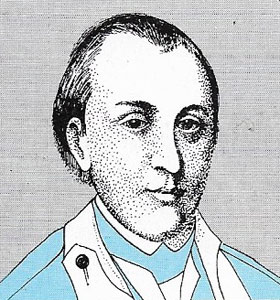 |
| The Marquis de Lafayette became a popular hero when he led the French volunteers who helped the American colonists break free from Britain. With other aristocrats he joined the National Assembly in 1789, presenting a declaration of rights and organizing the National Guard. A moderate reformer, he became trapped between Jacobin extremists and the court and fled in 1792. |
An economic slump began in the 1780s and the state of royal finances became so bad that an attempt was made to tax the privileged classes (Figure 2). They refused to pay and the king was forced, for the first time since 1614, to called the Estates-General. This met on May 5, 1789, but no progress toward reforms was made. The Third Estate – the bourgeoisie, or middle classes – tired of the lack of action of the aristocracy and clergy and on 17 June proclaimed itself a National Assembly with the intention of preparing a new constitution (Figures 3 and 4).
Storming of the Bastille
The Third Estate swore not to disperse from the assembly until reform had been promised. In reply the King ordered them to leave the hall, and also dismissed Jacques Necker (1732–1804), his most popular and liberal minister. At this the people of Paris rose in an uproar. On 14 July 1789, they seized arms from a military barracks and marched on the Bastille, the grim, hated prison, where, it was believed, many innocent people were incarcerated. After a few hours the governor was induced to surrender, and the crowd, frantic with excitement, poured in. They massacred the guards and set free the prisoners – of which there were only a handful it turned out. Then they razed the building to the ground.
Following the storming of the Bastille there was a general breakdown of social order throughout France with aristocratic property being looted or seized. The National Assembly stripped away the privileges of aristocracy and clergy and the king had to leave Versailles for the Tuileries palace in Paris.
The first years
The political turmoil continued over the next two years with attempts to establish a new constitution and with anti-royal feeling growing. The National Assembly, under the moderate influence of Count Mirabeau, passed a number of reforms. Although mob violence still broke out occasionally, this was generally checked by the new National Guard under General Lafayette. A month after the storming of the Bastille the National Assembly abolished all feudal rights and privileges belonging to the nobility. Soon afterwards they issued the Declaration of the Rights of Man. This stated among other things that all men are by nature equal and that the will of the people is supreme. Confiscation of aristocratic and Church land and wealth gave the new government welcome financial help, but an issue of paper currency – the assignats – soon led to renewed inflation. In June 1791 the king attempted to flee abroad but was recaptured at Varennes. Popular hostility to him increased when the Emperor of Austria and the King of Prussia issued a declaration saying that the ancient rights of Louis would soon be restored. In September a new constitution was introduced setting up a legislative assembly and giving the king strictly limited power. But tension rapidly grew between moderate constitutionalists and extreme anti-monarchists,
The reign of terror
By the end of 1791 power was slipping away from the moderates into the hands of the extreme revolutionaries. Of these the most important was a political group known as the Jacobins. The National Assembly was dissolved and the Legislative Assembly took its place. In April 1792 war was declared on Austria (Figure 5). As royalist armies backed by Austria and Prussia gathered on France's borders the mob demanded that the Assembly act against the king. In September Prussian armies invaded France, precipitating a massacre of captured aristocrats. An unexpected victory over the invaders at Valmy on 22 September relieved the pressure. On the same day, the crown was abolished and a France became a republic ruled by a Constitutional Assembly which was elected by the extremist Jacobins, the most radical group to hold power during the revolution.
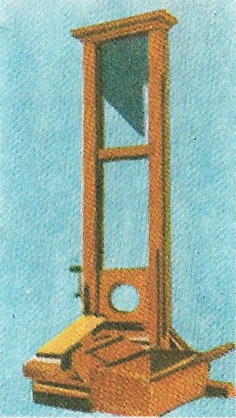 |
| The guillotine.
|
The Jacobins pressed for the King's execution. Despite the efforts of the more moderate party, the Girondins, on 21 January 1793 Louis was executed by the guillotine (Figure 6). In the following months defeats by the émigré armies, pro-royalist risings in La Vendée and the south, and continuing economic problems prompted the Assembly to appoint a Committee of Public safety to exercise emergency powers and to order total mobilization.
The Committee of Public Safety, dominated by Jacobins, was set up, and in June they arrested the leaders of the Girondins and guillotined them. The leaders of the Jacobins were a raucous lawyer called Danton, Maximilien Robespierre (1758–1794), who was learned, precise, and pitiless, and Marat, who was a bloodthirsty and ruthless man; to him the answer to all problems seemed to be more and more bloodshed.
During this time more than 40,000 people were arrested, imprisoned, and executed, often with no form of trial and on only slight suspicion of Royalist sympathy. In the midst of all this bloodshed and horror one heroic deed stands out: the assassination of Marat by a young Norman girl called Charlotte Corday. Like Joan of Arc, many centuries earlier, she felt she had a divine mission which was to save France from the monster.
Soon the Jacobin leaders began to quarrel among themselves. Danton wanted to call a halt to the slaughter that was going on in Paris; Robespierre wanted it to continue. The result was that Danton went to the guillotine, but Robespierre followed him there a few months later. The downfall of Robespierre brought an end to the reign of terror. A reaction set in with moderates seizing power. In 1795, another Constitution was prepared, not as democratic as the previous one, in which the main power lay in the hands of a five-man Executive Directorate.
Emergence of Napoleon
The Directorate made peace with Prussian and The Netherlands, but launched a major offensive against Austria by sending a young general, Napoleon Bonaparte (1769–1821) to campaign in Italy. He was brilliantly successful during 1796, forcing Austria out of the war. He then led an expedition to Egypt to cut Britain's communication with her Indian Empire, but he was finally forced to abandon the campaign when Horatio Nelson (1758–-1805) destroyed the French fleet at the Battle of the Nile in 1798. Meanwhile the Directorate had become profoundly unpopular with all sections of the population and when Napoleon returned in October 1799 he was able to engineer a coup that gave power to three consuls, of which he was the senior (Figure 7).
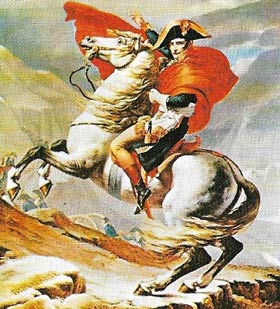 |
| Napoleon Bonaparte led the French armies in Italy in 1796–1797. Although the Directorate intended the campaign as a diversionary effort, Bonaparte won an extraordinary series of victories, inspiring his conscript troops and using a mobile strategy to defeat the conventional Austrian armies. Once again, in 1800, he led French troops into Italy, crossing the Alps to defeat the Austrians at the battle of Marengo. |
